Do you have a question about the TriangleTube CHALLENGER CC 85 and is the answer not in the manual?
Explains terms used in the manual for hazards or important information.
Provides general safety guidelines and product usage information.
Outlines adherence to local, state, national, and provincial codes for installation.
Guidelines for selecting an appropriate installation location for the appliance.
Checks and corrections required when replacing existing heating systems.
Specifies required distances from combustible materials for safe operation.
Special precautions for installing the appliance in a garage environment.
Details the built-in freeze protection mechanism for the boiler.
Identifies potential contaminants and their effects on the appliance.
Specifies air opening sizes and locations for proper ventilation.
Instructions for installing the direct vent and combustion air piping system.
Steps for safely removing an old unit from a shared venting system.
Specific installation requirements for Massachusetts, including CO detectors.
Guidance on safely unpacking and moving the appliance.
Procedures for securely mounting the appliance to a wall.
Best practices and requirements for wall bracket and mounting surface.
Specific steps for mounting the bracket to wall studs.
Instructions for mounting the bracket onto solid wall structures.
Guidance on lifting and securing the appliance onto the mounted bracket.
Instructions for installing the bracket to support appliance piping.
Standards and practices for all plumbing connections to the boiler.
Installation and discharge piping requirements for the pressure relief valve.
Information on the low water cutoff device and its system pressure requirements.
Guidelines for installing extra high temperature limits if required by codes.
Requirements for installing a backflow preventer on the make-up water supply.
Overview of piping configurations, including primary/secondary setups.
Guidance on sizing and installing expansion tanks for system water.
Specifics for diaphragm type expansion tanks and air vents.
Instructions for installing and maintaining closed-type expansion tanks.
Information on the required CH circulator and its function.
Guidance on sizing primary piping for space heating systems.
Diagram and instructions for zoning with separate circulators.
Diagram and instructions for zoning using zone valves.
Considerations for piping the boiler for radiant heating applications.
Installation advice for systems with chilled water or air handlers.
General advice on domestic water usage and temperature checks.
Details on minimum flow rates, max temperatures, and water quality limits.
Requirements for installing a field-supplied pressure relief valve.
Specifications for T&P relief valves when used with storage tanks.
Notes on field-supplied drain valves and fittings.
How to prevent relief valve weeping due to thermal expansion.
Preventing water shock and damage from fast-closing valves.
Installing a vacuum breaker to protect storage tanks from negative pressure.
Overview of domestic water piping diagrams and codes.
Installation and function of the factory-supplied thermostatic mixing valve.
Guidance on installing and controlling recirculation loops for hot water.
Considerations for integrating a storage tank for large DHW demands.
Step-by-step instructions for adjusting the thermostatic mixing valve temperature.
Instructions for properly installing the concentric vent/air system.
Steps for installing the condensate trap and drain line.
Procedures for connecting the gas supply piping to the appliance.
Details on natural gas pipe sizing, pressure, and orifice requirements.
Details on propane gas pipe sizing, pressure, and orifice requirements.
Standards for wiring, including NEC class and wire type.
Provides ladder and schematic diagrams for internal wiring.
Rules for field wiring, adhering to electrical codes.
Instructions for connecting the 120 VAC power supply.
Specifies the maximum AMP draw for the CH circulator.
Guidance on making low voltage connections to the control panel.
Instructions for installing and wiring room thermostats.
How to connect the CH primary circulator to the appliance.
Wiring for system circulators when using zone valves.
Information on connecting an outdoor sensor for variable temperature control.
Diagrams illustrating multiple zone wiring configurations.
Procedures for verifying water pH, hardness, and chlorine levels.
Steps to flush the system and remove any accumulated sediment.
Verifying antifreeze inhibitor levels and fluid characteristics.
A checklist of essential checks before initiating appliance operation.
Step-by-step guide to starting the CHALLENGER appliance.
Troubleshooting steps for when the appliance fails to start.
Verifying system piping, vent, and combustion air for proper function.
Instructions for physically mounting the outdoor temperature sensor.
Connecting the outdoor sensor wires to the control module.
Defining the relationship between outdoor temp and CH setpoint.
How to modify parameters for the outdoor reset function.
Comprehensive list of checks to perform after installation.
Form for recording installation details, readings, and installer information.
Annual maintenance tasks to be performed by a qualified technician.
Routine maintenance tasks for the appliance owner.
Detailed instructions for carrying out scheduled maintenance tasks.
Procedures for diagnosing and correcting owner-reported issues.
Verifying the area around the appliance is free of hazards.
Steps to clean and maintain the condensate drain system.
Ensuring ventilation openings are clear and functional.
Visual inspection of vent and air piping for issues.
Verifying the overall boiler system for proper installation and operation.
Procedure for accessing and inspecting internal components.
Inspecting and testing the pressure relief valve(s).
Inspecting the expansion tank for proper charge pressure.
Cleaning or replacing the ignition electrode.
Inspecting wiring for condition and ground continuity.
Verifying control wiring is in good condition and connected.
Reviewing and adjusting appliance control settings.
Executing the full start-up and checkout sequence.
Inspecting the burner flame pattern for proper combustion.
Measuring combustion levels and adjusting burner settings.
Procedures for cleaning the heat exchanger.
Discussing maintenance schedules and appliance behavior with the owner.
Safety precautions for dealing with combustion chamber insulation.
Diagrams showing the front and side views with connection labels.
| Model | CHALLENGER CC 85 |
|---|---|
| Type | Condensing Boiler |
| Input BTU/hr | 85, 000 |
| Efficiency | 95% |
| Fuel Type | Natural Gas or Propane |
| Heat Exchanger Material | Stainless Steel |
| Vent Diameter | 3 inches |
| Ignition | Electronic |
| Warranty | 10 years heat exchanger |
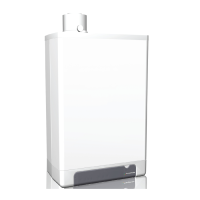
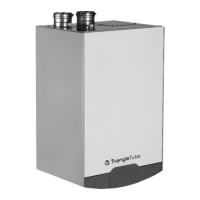
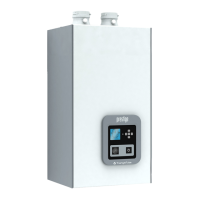
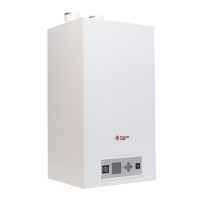
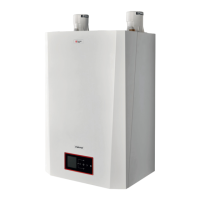
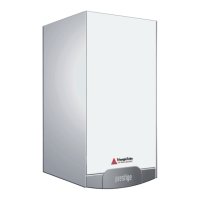
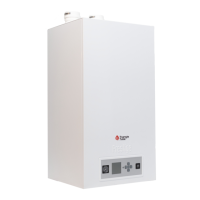
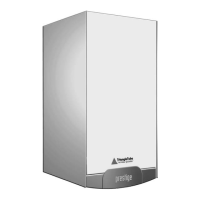
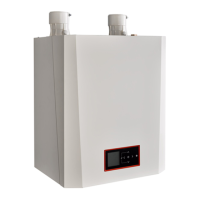
